Inhibition of type I procollagen synthesis by damaged collagen in photoaged skin and by collagenase-degraded collagen in vitro
- PMID: 11238041
- PMCID: PMC1850364
- DOI: 10.1016/S0002-9440(10)64040-0
Inhibition of type I procollagen synthesis by damaged collagen in photoaged skin and by collagenase-degraded collagen in vitro
Abstract
Type I and type III procollagen are reduced in photodamaged human skin. This reduction could result from increased degradation by metalloproteinases and/or from reduced procollagen synthesis. In the present study, we investigated type I procollagen production in photodamaged and sun-protected human skin. Skin samples from severely sun-damaged forearm skin and matched sun-protected hip skin from the same individuals were assessed for type I procollagen gene expression by in situ hybridization and for type I procollagen protein by immunostaining. Both mRNA and protein were reduced ( approximately 65 and 57%, respectively) in photodamaged forearm skin compared to sun-protected hip skin. We next investigated whether reduced type I procollagen production was because of inherently reduced capacity of skin fibroblasts in severely photodamaged forearm skin to synthesize procollagen, or whether contextual influences within photodamaged skin act to down-regulate type I procollagen synthesis. For these studies, fibroblasts from photodamaged skin and matched sun-protected skin were established in culture. Equivalent numbers of fibroblasts were isolated from the two skin sites. Fibroblasts from the two sites had similar growth capacities and produced virtually identical amounts of type I procollagen protein. These findings indicate that the lack of type I procollagen synthesis in sun-damaged skin is not because of irreversible damage to fibroblast collagen-synthetic capacity. It follows, therefore, that factors within the severely photodamaged skin may act in some manner to inhibit procollagen production by cells that are inherently capable of doing so. Interactions between fibroblasts and the collagenous extracellular matrix regulate type I procollagen synthesis. In sun-protected skin, collagen fibrils exist as a highly organized matrix. Fibroblasts are found within the matrix, in close apposition with collagen fibers. In photodamaged skin, collagen fibrils are shortened, thinned, and disorganized. The level of partially degraded collagen is approximately 3.6-fold greater in photodamaged skin than in sun-protected skin, and some fibroblasts are surrounded by debris. To model this situation, skin fibroblasts were cultured in vitro on intact collagen or on collagen that had been partially degraded by exposure to collagenolytic enzymes. Collagen that had been partially degraded by exposure to collagenolytic enzymes from either bacteria or human skin underwent contraction in the presence of dermal fibroblasts, whereas intact collagen did not. Fibroblasts cultured on collagen that had been exposed to either source of collagenolytic enzyme demonstrated reduced proliferative capacity (22 and 17% reduction on collagen degraded by bacterial collagenase or human skin collagenase, respectively) and synthesized less type I procollagen (36 and 88% reduction, respectively, on a per cell basis). Taken together, these findings indicate that 1) fibroblasts from photoaged and sun-protected skin are similar in their capacities for growth and type I procollagen production; and 2) the accumulation of partially degraded collagen observed in photodamaged skin may inhibit, by an as yet unidentified mechanism, type I procollagen synthesis.
Figures


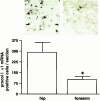
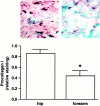
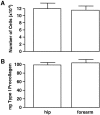

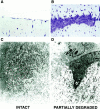
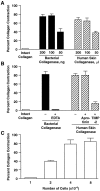
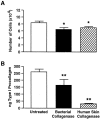
Similar articles
-
Induction of collagen by estradiol: difference between sun-protected and photodamaged human skin in vivo.Arch Dermatol. 2008 Sep;144(9):1129-40. doi: 10.1001/archderm.144.9.1129. Arch Dermatol. 2008. PMID: 18794456
-
Modulation of skin collagen metabolism in aged and photoaged human skin in vivo.J Invest Dermatol. 2001 Nov;117(5):1218-24. doi: 10.1046/j.0022-202x.2001.01544.x. J Invest Dermatol. 2001. PMID: 11710936
-
Vitamin A antagonizes decreased cell growth and elevated collagen-degrading matrix metalloproteinases and stimulates collagen accumulation in naturally aged human skin.J Invest Dermatol. 2000 Mar;114(3):480-6. doi: 10.1046/j.1523-1747.2000.00902.x. J Invest Dermatol. 2000. PMID: 10692106
-
Possible involvement of basement membrane damage in skin photoaging.J Investig Dermatol Symp Proc. 2009 Aug;14(1):2-7. doi: 10.1038/jidsymp.2009.5. J Investig Dermatol Symp Proc. 2009. PMID: 19675545 Review.
-
Skin development in bony fish with particular emphasis on collagen deposition in the dermis of the zebrafish (Danio rerio).Int J Dev Biol. 2004;48(2-3):217-31. doi: 10.1387/ijdb.15272388. Int J Dev Biol. 2004. PMID: 15272388 Review.
Cited by
-
Antiphotoaging effects of solvent fractions isolated from Allomyrina dichotoma larvae extract.Biochem Biophys Rep. 2024 Feb 13;38:101660. doi: 10.1016/j.bbrep.2024.101660. eCollection 2024 Jul. Biochem Biophys Rep. 2024. PMID: 38375419 Free PMC article.
-
Structural and Functional Changes and Possible Molecular Mechanisms in Aged Skin.Int J Mol Sci. 2021 Nov 19;22(22):12489. doi: 10.3390/ijms222212489. Int J Mol Sci. 2021. PMID: 34830368 Free PMC article. Review.
-
Attenuation of UVB-Induced Photo-Aging by Polyphenolic-Rich Spatholobus Suberectus Stem Extract Via Modulation of MAPK/AP-1/MMPs Signaling in Human Keratinocytes.Nutrients. 2019 Jun 14;11(6):1341. doi: 10.3390/nu11061341. Nutrients. 2019. PMID: 31207929 Free PMC article.
-
Adipocytes in skin health and disease.Cold Spring Harb Perspect Med. 2014 Mar 1;4(3):a015271. doi: 10.1101/cshperspect.a015271. Cold Spring Harb Perspect Med. 2014. PMID: 24591537 Free PMC article. Review.
-
Deep Learning-Based CT Radiomics for Feature Representation and Analysis of Aging Characteristics of Asian Bony Orbit.J Craniofac Surg. 2022 Jan-Feb 01;33(1):312-318. doi: 10.1097/SCS.0000000000008198. J Craniofac Surg. 2022. PMID: 34560737 Free PMC article.
References
-
- Smith JG, Davidson EA, Sams WM, Clark RD: Alterations in human dermal connective tissue with age and chronic sun damage. J Invest Dermatol 1962, 39:347-350 - PubMed
-
- Kligman AM, Balin AK: Aging of human skin. Balin AK Kligman AM eds. Aging and the Human Skin. 1989, :pp 1-11 Raven Press, New York
-
- Schwartz E, Cruickshank FA, Perlish JS, Fleischmajer R: Alterations in dermal collagen in ultraviolet irradiated hairless mice. J Invest Dermatol 1989, 93:142-146 - PubMed
-
- Marks R (ed): Sun-Damaged Skin. London, Martin Dunitz, 1992
-
- Maloney SJ, Edmonds SH, Giddens LD, Learn DB: The hairless mouse model of photoaging: evaluation of the relationship between dermal elastin, collagen, skin thickness and wrinkles. Photochem Photobiol 1992, 56:505-511 - PubMed
Publication types
MeSH terms
Substances
Grants and funding
LinkOut - more resources
Full Text Sources
Other Literature Sources
Medical

